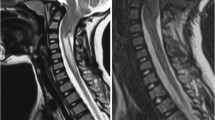Abstract
Purpose
There are few researches that demonstrate the relationship between the extent of syringomyelia and sagittal alignment of the cervical spine. The purpose of this study is to investigate the correlation between the change of syrinx size and cervical alignment.
Methods
From January 2001 to June 2008, we operated on 207 patients who had syringomyelia. The associated diseases were categorized by Chiari I malformation, tumor, trauma, spinal stenotic lesion, inflammatory disease and idiopathic causes. Thirty patients who had Chiari I malformation associated with syringomyelia and who underwent foramen magnum decompression (FMD), participated in this study. We excluded patients with scoliosis, cervical instrumentation, tumor, trauma, myelomeningocele, hydrocephalus, tethered cord and congenital vertebral anomalies. Lateral radiographs in neutral and magnetic resonance imaging were taken pre- and postoperatively.
Results
Mean follow-up was 6.5 ± 1.5 years (ranged from 4.0 to 9.5 years). The mean pre- and postoperative lordosis angles at C2–C7 were −5.9° ± 1.0° and −10.4° ± 1.0°, respectively (P = 0.001). There was significant correlation between the differences of syrinx width and the cervical lordotic angles before and after surgery (P = 0.016). After FMD, syringomyelia and cervical alignment improved in 28 (93.3 %) and 25 (85.18 %) of 30 patients, respectively. There was significant correlation between recovery rate by Japanese Orthopaedic Association scores and the difference of the cervical lordotic angles before and after surgery (P = 0.022).
Conclusions
The present results demonstrate that the decrease of syrinx size by FMD may restore the cervical lordosis. We suggest that the postoperative cervical alignment might be a predictive factor for neurological outcome.



Similar content being viewed by others
Abbreviations
- FMD:
-
Foramen magnum decompression
- MRI:
-
Magnetic resonance imaging
- JOA:
-
Japanese Orthopaedic Association
References
Akhtar OH, Rowe DE (2008) Syringomyelia-associated scoliosis with and without the Chiari I malformation. J Am Acad Orthop Surg 16:407–417
Attenello FJ, McGirt MJ, Gathinji M, Datoo G, Atiba A, Weingart J, Carson B, Jallo GI (2008) Outcome of Chiari-associated syringomyelia after hindbrain decompression in children: analysis of 49 consecutive cases. Neurosurgery 62:1307–1313 (discussion 1313)
Brockmeyer D, Gollogly S, Smith JT (2003) Scoliosis associated with Chiari 1 malformations: the effect of suboccipital decompression on scoliosis curve progression: a preliminary study. Spine 28:2505–2509
Dang NR, Moreau MJ, Hill DL, Mahood JK, Raso J (2005) Intra-observer reproducibility and interobserver reliability of the radiographic parameters in the spinal deformity study group’s AIS radiographic measurement manual. Spine (Phila Pa 1976) 30:1064–1069
Emery E, Redondo A, Rey A (1997) Syringomyelia and Arnold Chiari in scoliosis initially classified as idiopathic: experience with 25 patients. Eur Spine J 6:158–162
Eule JM, Erickson MA, O’Brien MF, Handler M (2002) Chiari I malformation associated with syringomyelia and scoliosis: a twenty-year review of surgical and nonsurgical treatment in a pediatric population. Spine 27:1451–1455
Harrison DD, Janik TJ, Troyanovich SJ, Holland B (1996) Comparisons of lordotic cervical spine curvatures to a theoretical ideal model of the static sagittal cervical spine. Spine (Phila Pa 1976) 21:667–675
Huebert HT, MacKinnon WB (1969) Syringomyelia and scoliosis. J Bone Joint Surg Br 51:338–343
Kolban M, Darczuk J, Chmielnicki M (2005) Diagnosis of syringomyelia and Chiari malformations in patients with scoliosis. Ortop Traumatol Rehabil 7:36–41
Milhorat TH (2000) Classification of syringomyelia. Neurosurg Focus 8:E1
Mollano AV, Weinstein SL, Menezes AH (2005) Significant scoliosis regression following syringomyelia decompression: case report. Iowa Orthop J 25:57–59
Olivero WC (1999) Pathogenesis of syringomyelia. AJNR Am J Neuroradiol 20:2024–2025
Ono A, Suetsuna F, Ueyama K, Yokoyama T, Aburakawa S, Numasawa T, Wada K, Toh S (2007) Surgical outcomes in adult patients with syringomyelia associated with Chiari malformation type I: the relationship between scoliosis and neurological findings. J Neurosurg Spine 6:216–221
Ozerdemoglu RA, Denis F, Transfeldt EE (2003) Scoliosis associated with syringomyelia: clinical and radiologic correlation. Spine 28:1410–1417
Sengupta DK, Dorgan J, Findlay GF (2000) Can hindbrain decompression for syringomyelia lead to regression of scoliosis? Eur Spine J 9:198–201
Spiegel DA, Flynn JM, Stasikelis PJ, Dormans JP, Drummond DS, Gabriel KR, Loder RT (2003) Scoliotic curve patterns in patients with Chiari I malformation and/or syringomyelia. Spine 28:2139–2146
Vannemreddy SS, Rowed DW, Bharatwal N (2002) Posttraumatic syringomyelia: predisposing factors. Br J Neurosurg 16:276–283
Whitaker C, Schoenecker PL, Lenke LG (2003) Hyperkyphosis as an indicator of syringomyelia in idiopathic scoliosis: a case report. Spine (Phila Pa 1976) 28:E16–E20
Yonenobu K, Abumi K, Nagata K, Taketomi E, Ueyama K (2001) Interobserver and intraobserver reliability of the japanese orthopaedic association scoring system for evaluation of cervical compression myelopathy. Spine (Phila Pa 1976) 26:1890–1894 (discussion 1895)
Zderkiewicz E, Kaczmarczyk R (2007) Syringomyelia and Arnold-Chiari syndrome. Neurol Neurochir Pol 41:355–360
Zhang ZQ, Chen YQ, Chen YA, Wu X, Wang YB, Li XG (2008) Chiari I malformation associated with syringomyelia: a retrospective study of 316 surgically treated patients. Spinal Cord 46:358–363
Acknowledgments
The manuscript submitted does not contain information about medical device(s)/drug(s). No funds were received in support of this work. No benefits in any form have been or will be received from a commercial party related directly or indirectly to the subject of this manuscript.
Conflict of interest
None of the authors has any conflict of interest in the subject under discussion in this paper.
Author information
Authors and Affiliations
Corresponding author
Rights and permissions
About this article
Cite this article
Hyun, S.J., Moon, K.Y., Kwon, J.W. et al. Chiari I malformation associated with syringomyelia: can foramen magnum decompression lead to restore cervical alignment?. Eur Spine J 22, 2520–2525 (2013). https://doi.org/10.1007/s00586-013-2876-4
Received:
Revised:
Accepted:
Published:
Issue Date:
DOI: https://doi.org/10.1007/s00586-013-2876-4




